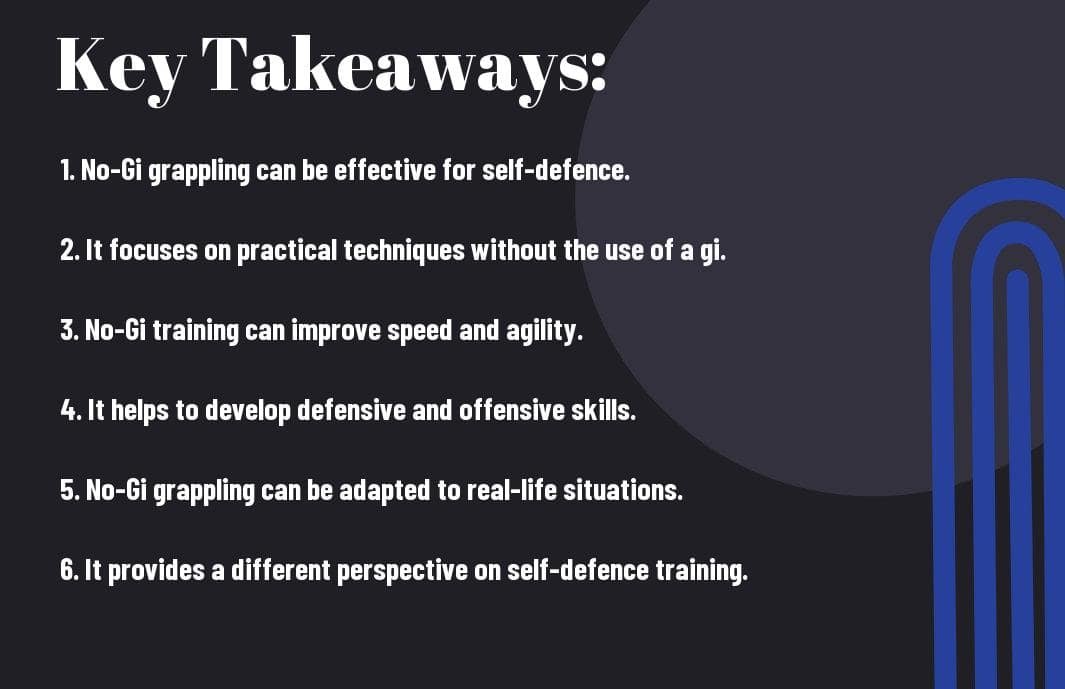Are you wondering whether no-gi grappling is a viable form of self-defence? In this blog post, you will discover the key advantages and potential risks of utilising no-gi grappling in a self-defence situation. You will gain an understanding of the limitations and benefits of this specific martial art form and whether it is an effective method for protecting yourself in real-life scenarios.
Key Takeaways:
- No-Gi grappling can be effective for self-defence: No-Gi grappling techniques can be highly effective in a self-defence situation, allowing individuals to control and subdue opponents without relying on clothing grips.
- Emphasis on practical techniques: No-Gi grappling focuses on practical techniques that are adaptable to real-world scenarios, making it a valuable skill for self-defence purposes.
- Increased agility and speed: Training in No-Gi grappling can improve agility and speed, essential for evading and counter-attacking in a self-defence situation.
- Adaptability to various environments: No-Gi grappling can be applied in a range of environments, from confined spaces to uneven surfaces, making it well-suited for self-defence in diverse settings.
- Enhanced confidence and mental resilience: The practice of No-Gi grappling can boost confidence and mental resilience, providing individuals with the tools and mindset to defend themselves effectively in dangerous situations.

Understanding No-Gi Grappling
When it comes to self-defence, understanding the principles and techniques of no-gi grappling can be a crucial asset. No-gi grappling refers to a form of grappling and submission wrestling that is practiced without the traditional uniform or “gi”. In no-gi grappling, practitioners wear rash guards and shorts or spats, allowing for a faster and more dynamic style of combat.
Definition and Core Principles
No-gi grappling is centred around the principles of leverage, body positioning, and joint manipulation without the use of a gi. It incorporates techniques from Brazilian Jiu-Jitsu, wrestling, judo, and sambo, and is commonly practiced in mixed martial arts (MMA) and submission grappling competitions. The primary focus is on controlling an opponent, gaining dominant positions, and ultimately submitting them using joint locks or chokes.
Comparison to Gi Grappling
When comparing no-gi to gi grappling, there are several key differences. In no-gi grappling, the lack of a gi eliminates the ability to grip and control your opponent in the same way you would with one. This means that techniques relying on gi grips have to be adapted or substituted with alternative methods. On the other hand, the absence of a gi allows for faster movement and places a greater emphasis on body positioning and controlling your opponent with a stronger reliance on clinches, underhooks, and overhooks.
| Aspect | No-Gi Grappling |
| Grip Strength | Less emphasis on gripping due to lack of a gi |
| Movement | Allows for quicker and more dynamic movement |
| Body Control | Greater emphasis on body positioning and control techniques |
No-Gi Grappling Techniques for Self-Defense
In the context of self-defense, no-gi grappling techniques can provide you with valuable skills to protect yourself in real-life situations. Whether you are a beginner or an experienced practitioner, incorporating no-gi grappling into your self-defense training can significantly enhance your ability to defend against various threats. If you are wondering which is more effective for self-defense, Gi or no-Gi BJJ, you can find a detailed discussion on Is Gi or no Gi BJJ for self-defense?
Common No-Gi Moves Applicable to Self-Defense
Common no-gi grappling techniques such as takedowns, escapes, and submissions can be effectively applied in self-defense situations. Takedowns such as the double leg or single leg takedown can quickly neutralise an attacker and create distance, allowing you to escape to safety. Escapes from dominant positions, such as the mount or side control, are crucial for getting out from underneath an aggressor and regaining control. Submissions like chokes and joint locks can be used to incapacitate an attacker if necessary.
Training Methods to Improve Defensive Skills
To enhance your defensive skills, it is essential to incorporate specific training methods into your no-gi grappling practice. Focus on developing your reflexes and reaction time to counter and escape from potential threats quickly. Sparring with a resisting opponent will help you to simulate real-world scenarios and adapt your techniques to unpredictable situations. Additionally, integrating self-defence scenarios into your training will enable you to apply your grappling skills in practical situations.
By learning and mastering these no-gi grappling techniques for self-defense, you will have the confidence and ability to protect yourself in potentially dangerous situations. Emphasising the important techniques and training methods is essential for equipping you with the skills to defend against various threats effectively. So, remember to focus on the common no-gi moves applicable to self-defense and incorporate suitable training methods to improve your defensive skills.
Practical Application of No-Gi Grappling
When it comes to practical application, no-gi grappling is extremely effective for self-defence. Without the use of a traditional uniform or gi, practitioners are forced to rely on leverage, body positioning, and technique rather than grip and fabric manipulation. This makes no-gi grappling a valuable skill in real-life confrontations where the situation may not allow for the use of traditional martial arts attire.
Real-life Scenarios for Self-Defense
Real-life scenarios for self-defence can be unpredictable and chaotic. No-gi grappling teaches you how to control and neutralise an opponent without relying on the use of clothing grips. This skill is invaluable in situations where the need for self-defence arises in everyday clothing or in close quarters where grabbing traditional gi grips may not be possible. Being able to effectively apply no-gi grappling techniques in real-life scenarios can give you a significant advantage in defending yourself in a variety of situations.
Limitations and Considerations
While no-gi grappling is highly effective for self-defence, it’s important to consider its limitations. Without the use of a gi, certain techniques and submissions may not be as easily applicable. Additionally, the lack of fabric to grip onto can present challenges in controlling and manipulating your opponent. It’s essential to adapt your grappling strategies to account for these limitations and focus on using the strengths of no-gi grappling, such as speed and agility, to your advantage in self-defence situations.
Supplementing No-Gi Grappling with Other Martial Arts
When it comes to self-defence, having a well-rounded skill set is crucial. While no-gi grappling can be highly effective, supplementing it with other martial arts can further enhance your ability to defend yourself in a variety of situations. By integrating different disciplines, you can become a more versatile and well-equipped defender.
Integrating Striking and Ground Defense
Integrating striking techniques from disciplines such as boxing, Muay Thai, or kickboxing into your training can help you develop a more comprehensive self-defence skill set. By learning how to effectively strike your opponent, you can create distance and create opportunities to apply your grappling techniques. Additionally, incorporating ground defense techniques from Brazilian Jiu-Jitsu and judo can help you effectively defend yourself if the fight ends up on the ground. This combination of striking and ground defense can significantly increase your ability to control a self-defence situation.
Building a Comprehensive Self-Defense Strategy
Building a comprehensive self-defence strategy means understanding your strengths and weaknesses and being prepared for any situation. By combining no-gi grappling with other martial arts, you can develop a well-rounded approach to self-defence. This includes learning how to defend against strikes, takedowns, and various grappling techniques. By building a comprehensive strategy, you can confidently handle a variety of real-world threats and increase your chances of safely escaping a dangerous situation.
Adding other martial arts to your training can supplement your no-gi grappling skills, making you a more versatile and confident defender. By integrating striking and ground defense techniques, you can effectively control a self-defence situation and significantly increase your ability to defend yourself. Building a comprehensive self-defence strategy not only enhances your overall skill set but also prepares you for a wide range of potential threats.
Is No-Gi Grappling Effective for Self-Defense?
With these considerations, you can see that No-Gi grappling can be effective for self-defense in certain situations. It allows you to learn practical techniques that can be applied in real-life confrontations, and it prepares you for the unpredictable nature of street fights. However, it’s important to remember that training in a Gi can also have its benefits for self-defense, as it provides a different set of skills and strategies. To further explore the debate between Gi and No Gi for self-defense, you can read this article on Gi or No Gi for Self Defense?
FAQ
Q: Is No-Gi Grappling Effective for Self-Defense?
A: Yes, No-Gi grappling can be very effective for self-defense as it focuses on controlling an opponent without the use of a uniform or clothing, which is often the case in real-life altercations.
Q: What is No-Gi Grappling?
A: No-Gi grappling is a form of grappling and submission fighting that does not require the traditional uniform or “gi.” It focuses on using techniques and leverage to control and subdue opponents without the use of clothing grips.
Q: How Does No-Gi Grappling Differ from Traditional Grappling?
A: No-Gi grappling differs from traditional grappling in that it does not rely on grip and control of the opponent’s uniform. This makes it more applicable to real-life self-defense scenarios where an opponent may not be wearing a gi.
Q: Can No-Gi Grappling Help in Self-Defense Situations?
A: Yes, the techniques and principles of No-Gi grappling can be applied effectively in self-defense situations, as they focus on controlling and neutralizing an opponent without the use of striking or weapons.
Q: Is No-Gi Grappling Suitable for Everyone?
A: No-Gi grappling can be suitable for people of all ages and fitness levels, as it can be adapted to different physical capabilities. However, it is important to train under the guidance of a qualified instructor to ensure safety and proper technique.
Q: What Are Some Notable Techniques in No-Gi Grappling for Self-Defense?
A: Some notable techniques in No-Gi grappling for self-defense include takedowns, control positions such as mount and side control, and submission holds such as chokes and joint locks.
Q: Is No-Gi Grappling Effective in Real-Life Altercations?
A: Yes, No-Gi grappling can be very effective in real-life altercations, as it equips individuals with the skills to control and neutralize an opponent without relying on strikes or weapons, making it a practical option for self-defense.



